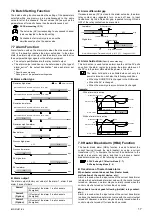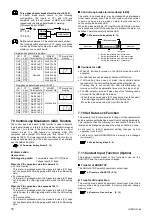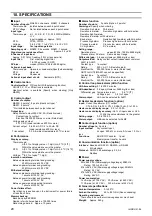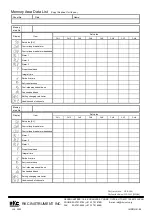
IMR01H01-E4
18
Three-phase heater break alarm function (Z-168):
A heater break alarm occurs in the following
configuration. The inputs of CT1 and CT5 are
compared with the set values of HBA1 and HBA2,
respectively to decide heater break or welding.
[Corresponding to MA900]
Input
Occurrence of alarm
Output
CT1 (CH1)
HBA1
HBA output
CT5 (CH1)
HBA2
Relationship between CT input and channel number:
The following table shows which CT input corresponds
to what input channel number and what CT monitoring
display you can check it with.
Single-phase heater break alarm
CH
No.
CT
input
MA900
Terminal No.
MA901
Terminal No.
CT monitoring
display
CH1
CT1
No.25 to 26
No.37 to 38
CH2
CT2
No.25 to 27
No.37 to 39
CH3
CT3
No.28 to 29
No.40 to 41
CH4
CT4
No.28 to 30
No.40 to 42
CH5
CT5
No.43 to 44
CH6
CT6
No.43 to 45
CH7
CT7
No.46 to 47
CH8
CT8
No.46 to 48
Three-phase heater break alarm (Z-168)
CH
No.
CT
input
MA900
Terminal No.
MA901
Terminal No.
CT monitoring
display
CH1
CT1
No.25 to 26
CH2
CT2
No.25 to 27
CH3
CT3
No.28 to 29
CH4
CT4
No.28 to 30
CH1
CT5
No.31 to 32
CH2
CT6
No.31 to 33
CH3
CT7
No.34 to 35
CH4
CT8
No.34 to 36
7.9 Control Loop Break Alarm
(LBA)
Function
The control loop break alarm (LBA) function is used to detect a
load (heater) break or a failure in the external actuator (magnet
relay, etc.), or a failure in the control loop caused by an input
(sensor) break. The LBA function is activated when PID
computed value (output ON time/cycle) falls below 0 % or
exceeds 100 %. The time required for the LBA output to turn on
includes both the time from the initial occurrence of loop failure
and the LBA setting time.
5.5 Parameter Setting Mode (P. 10)
"#
Alarm action
Heat control :
LBA triggering width:
Temperature input 2
°
C [
°
F] fixed
Voltage input 2 % fixed
When the PID computed value falls below 0 %
:
•
For direct action:
This alarm is produced when the measured value (PV) does
not rise beyond the LBA triggering width within the LBA setting
time.
•
For reverse action:
This alarm is produced when the measured value (PV) does
not fall below the LBA triggering width within the LBA setting
time.
When the PID computed value exceeds 100 %
:
•
For direct action:
This alarm is produced when the measured value (PV) does
not fall below the LBA triggering width within the LBA setting
time.
•
For reverse action:
This alarm is produced when the measured value (PV) does
not rise beyond the LBA triggering width within the LBA setting
time.
"#
"#
"#
"#
Control loop break alarm deadband (LBD)
The control loop break alarm may be produced by disturbances
(other heat sources) even if the control system is not abnormal.
In such a case, an area in which no alarm is produced can be
set by setting the desired LBD.
When the measured value (PV) is within the LBD area, no alarm
is produced even if all of the conditions to produce the alarm are
satisfied. Therefore, carefully set the LBD.
5.5 Parameter Setting Mode (P. 10)
LBD differential gap
Alarm area
Alarm area
Non-alarm area
A B
SV LBD
set
value
Low
High
"#
"#
"#
"#
Cautions for LBA
•
When AT function is turned on, the LBA function can not be
activated.
•
No LBA function can be used at heat/cool PID action.
•
If LBA setting time does not match the controlled object
requirements, the LBA setting time should be lengthened.
If setting time is not correct, the LBA will malfunction by
turning on or off at inappropriate times or not turning on at all.
•
The LBA output is turned off when any of the following cases
occurs with the LBA output turned on.
-
When the measured value (PV) rises beyond (or falls below)
the LBA triggering width within the LBA setting time
-
When the measured value (PV) is within the LBD
7.10 Set Data Lock Function
The set data lock function permits locking of critical parameters
and prevents unauthorized personnel from changing parameters.
This instrument has the following two lock levels. The two lock
levels can be changed even when the whole set data is locked.
•
Lock level to restrict parameter setting changes by key
operation (Lock level 1)
•
Lock level to restrict RUN/STOP and memory area changes
(Lock level 2)
5.4 Setup Setting Mode (P. 8)
7.11 Contact Input Function (Option)
The external contact signal of this instrument can do the
RUN/STOP and the memory area changes.
"#
"#
"#
"#
Transfer of RUN/STOP
The RUN or STOP selects by external contact input
.
6.3 Transfer of RUN/STOP (P. 14)
"#
Transfer of Control Area
The memory area selects by external contact input. Select one
memory area among memorized 8 memory area and change
memory area.
6.4 Transfer of Control Area (P. 15)
A:
During temperature rise: Alarm area
During temperature fall: Non-alarm area
B:
During temperature rise: Non-alarm area
During temperature fall: Alarm area
Unused
No function





































